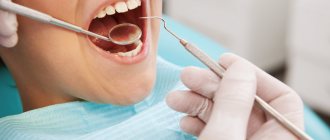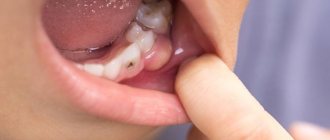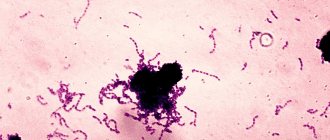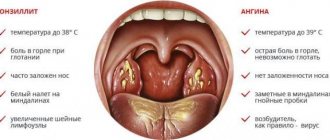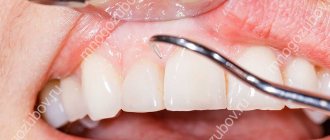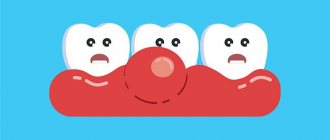Many dental diseases develop latently for quite a long time and, like many other diseases, in the first stages of development they are easily and simply controlled, for example cysts, which can be easily treated with conservative and non-surgical methods, the main thing is not to let the problem take its course.
The main problem of diagnosis and timely dental treatment is that patients, who remember what dentistry was like in the USSR, prefer to endure and ignore the initial symptoms “until the last” and turn to the dentist after the development of complications or already in advanced situations, when without surgical intervention not enough.
In addition, there are a number of diseases that appear and develop without pain or discomfort, asymptomatically, and therefore are discovered completely by chance on an x-ray or already at the stage when there are visible signs of inflammation and the preservation of the tooth becomes doubtful. Such dangerous and hidden pathological processes include a dental cyst, which does not manifest itself in any way, is detected by chance and so surprises patients with completely unexpected worries and expenses.
Laser treatment of cysts is the best therapeutic method of treatment
Treatment of dental cysts is possible! The specialists of the Bionic Dentis clinic prove this every day.
Dental clinic "Bionic Dentis" is the No. 1 clinic in Russia and the CIS countries for the treatment of dental cysts with a laser . We have the most experience in treating this disease and annually admit more than 1000 patients in this area of activity. The clinic's doctors are recognized in the professional community as experts in laser cyst treatment, conducting educational courses and training specialists in this technique.
Specializing in laser treatment, our dental center presents in the Russian Federation an exclusive technique based on the use of the latest generation dental laser SiroLaser Sirona SIEMENS (Germany).
Russia leads in the number of patients with dental cysts, because the level of root canal treatment in dental clinics in our country is prohibitively low. A public dentist, even acting according to the instructions of the Ministry of Health, works according to an outdated technique, which does not give a positive result in the long term and leads to the development of a dental cyst.
Classification of dental cysts
There are not many types of cysts, so understanding them is not difficult. Four main types are distinguished by location:
- wisdom tooth cyst;
— a cyst due to an illiterate (unprofessional) installed dental crown;
- a cyst that arose as a result of the influence of a third-party infectious disease (sinusitis);
- a cyst localized in the area of the front teeth.
At the same time, a classification is used based on previous circumstances preceding the occurrence of the cyst:
- a disease caused by poor-quality removal of one or more teeth;
— periodontal type cyst, provoked by an inflammatory process in the gums;
- a cyst caused by the growth of a wisdom tooth (retromolar or paradental);
- a cyst that occurs in children, first during the period of the appearance of milk (follicular) teeth, and then molars (eruption cyst);
— a cyst that arose as a complication of periodontitis (radicular);
— a situation is also possible in which the tissue forming the tooth degenerates (keratocyst).
Methods for treating dental cysts
All methods of treating dental cysts can be divided into surgical and therapeutic.
Surgical methods for treating cysts include:
- Cystotomy.
- Cystectomy.
- Resection of the apex of the tooth root.
All these methods are associated with surgical intervention (operation) and require long periods of rehabilitation and healing, and are always accompanied by pain in the postoperative period and massive swelling.
Laser treatment of dental cysts was developed in Germany more than 10 years ago. Over the years, this technique has received worldwide recognition from dentists and patients. The high effectiveness of this treatment method has been proven by more than 900 clinical studies.
But the main problem with surgical treatment methods is that their use has a very high percentage of relapses. Approximately 45% of cases of recurrence of dental cysts.
Operational methods
Surgical therapy for dental cysts is performed when the cavity is large, there is frequent pain and swelling, and there is a crown on the tooth. There are three methods for removing formation:
- Cystectomy. The essence of the procedure is to remove the cyst along with its contents and surrounding affected tissue. It is difficult to carry out such an operation without surgical specialization, and therefore there are strict indications for it: the absence of acute inflammation in the cyst cavity, the absence of teeth in the contents of the cyst, its location on the upper jaw with penetration into the maxillary sinus, or within two teeth.
- Hemisection. Such a surgical intervention involves removing not only the cyst, but also the root of the affected tooth along with part of the crown. After this, the enamel is cleaned and a new crown is placed to hide the defect.
- Cystotomy. The essence of the operation is to remove the anterior wall of the cyst. The main disadvantage is the long recovery period. Indications for its implementation: localization of a cavity in the lower jaw with significant thinning of its wall, destruction of the palatal plate or the bone floor of the nose, a large size of the cyst, occupying more than three adjacent teeth.
The first type of surgical intervention is the most preferable, but it is not always possible to perform it. In the most advanced situations, the doctor has to remove the entire tooth, followed by implantation, and sometimes bone grafting. Recently, dentists are increasingly trying to get rid of cysts using a laser. The technique has not yet reached its perfection, so patients are advised not to take unnecessary risks.
Unique. 100% channel processing. Laser technique
Let's look at what symptoms indicate that you have a dental cyst:
- Abscess on the gum.
- Flux on the gum.
- It feels like the tooth has grown and is taller than the rest.
- Pain from chewing hard food.
- Fistula on the gum.
These signs are a suppurating tooth cyst. If the described symptoms appear, you should urgently consult a dentist; the fact is that pus can quickly spread through the channels in the bone and reach such vital organs as the eye and ear, which leads to dire consequences.
However, a dental cyst would not be such an insidious disease if it immediately gave clear symptoms. The fact is that in 90 percent of cases, the cyst is completely asymptomatic. The patient does not even suspect that a dangerous disease is maturing in his jaw bone. Often, the patient undergoes a routine examination - a panoramic photograph, which reveals a dental cyst. Let us note right away: even if the cyst does not make itself felt and does not hurt, it must be treated urgently. If left untreated, it leads to serious complications:
- Suppuration of the cyst.
- Compression of nerves, which leads to paresthesia (numbness) of part of the face.
- Destruction of the jaw, up to a fracture of the lower jaw. If the cyst reaches a significant size, the bone becomes brittle and brittle. Even chewing hard food can cause a broken jaw.
- Cysts of the upper jaw in 99% of cases lead to sinusitis. This is a serious and unpleasant disease of the paranasal sinuses that is accompanied by unbearable headaches and nasal congestion.
Dental cyst
The formation of a dental cyst does not occur without a reason.
This can be preceded by a variety of factors, but they are all associated with damage to tissues and the root system, as well as infection and weakened immunity. The formation of a dental tumor can be provoked by:
- jaw or tooth injury;
- infection during dental treatment;
- Chronic ENT diseases;
- pulpitis, periodontitis and periodontitis;
- tissue inflammation after prosthetics;
- deviations in teething;
- deep caries.
The pathological formation is localized mainly on the tooth roots. It is benign in nature and is a closed capsule with liquid inside. The formation of a capsule is a protective reaction of the body to prevent the spread of infection.
The tooth cyst grows slowly. Its size can range from 1 mm to 3 cm in diameter. Small tumors are amenable to therapeutic treatment. Large capsules are removed, as there is a risk of rupture of the cyst, or its degeneration into a malignant form.
More details about the technique:
The dentist drills a small hole in the tooth on which the cyst is located. On the front teeth, this hole is located behind the tooth, on the lateral teeth, on top.
The doctor’s goal is to get to the root canals of the tooth, which are located in its center (the pulp of the tooth).
Once access to the nerve is achieved, the dentist removes the contents of the root canal, whether it is an inflamed tooth nerve or an infected tooth canal filling material after poor treatment.
Root canal treatment is not performed blindly. In our clinic, endodontists use a special device: a computerized root canal cleaning system from VDW GOLG (Germany).
Special titanium instruments - MTWO files - with progressive movements under the control of a microprocessor, millimeter by millimeter, clear the root canal, making it smoother, cleaner and straighter. The use of machine computer technology for canal processing in our clinic has a number of advantages:
- reducing the risk of tool breakage and jamming in the tooth canal.
- improving the quality of tooth canal treatment
- increasing the channel processing speed by more than 10 times compared to the manual method.
- eliminates the risk of uncontrolled penetration beyond the apex of the root canal and injury to periapical tissues.
Constant monitoring of canal clearing is carried out by a VDW apex locator (Germany) and the main stages of treatment are controlled using a radiovisiograph XIOS Sirona (Germany), which is installed in each office and allows you to do research without interrupting treatment.
A feature of the diagnostic equipment we use is minimal X-ray exposure to the patient and the resulting high-definition image.
Sometimes it takes 1 - 1.5 hours to clean and unfill the root canal.
After mechanical cleaning and expansion of the canal, they begin its ultrasonic treatment. Scientific research in recent years has proven that microscopic branches extend from a large root canal, which are the main reservoir for bacteria that cause dental cysts. It is not possible to clear these microtubules with files, but our clinic is equipped with a SiroSonic Sirona (Germany) ultrasonic root canal treatment system. This development by the German company SIEMENS ensures the penetration of a disinfectant solution into microscopic tubules and pores, killing microbes there and chemically sterilizing the root canal.
After sterilizing the root canal with chemicals and ultrasound, it is the turn of the SiroLaser laser dental unit. The dentist penetrates the cyst through the root canal and treats it with a laser. Thanks to the unique flexible light guides of our laser, the dentist can penetrate a dental cyst even through a curved canal. This innovation has made the SiroLaser the best in its class.
After laser treatment, the dentist performs laser sterilization of the root canals of the tooth and the cavity in the bone. This allows for 100 percent disinfection of infected tooth tissues, which eliminates the recurrence of a cyst in a given tooth.
After laser sterilization, the drug is installed. This long-acting substance stimulates bone tissue regeneration and tissue disinfection for a period of 4-6 months.
A lighted, especially strong temporary filling or temporary crown is installed on the tooth.
Treatment of dental cysts in 1 visit - we guarantee our patients the use of the world's best achievements in dental treatment.
Unlike the ineffective classical method of treating dental cysts by placing calcium in the root canals, when the patient needs to visit the dental clinic every week for six months, laser treatment of cysts at the Bionic Dentis clinic is carried out in one visit!
After 4-6 months, a radiovisiographic study is performed to confirm tissue regeneration and the healing process in the bone.
The second stage of dental treatment is no less important than laser treatment of a dental cyst.
3D filling of the root canal of a tooth after laser treatment of a cyst.
To complete the treatment of the tooth and prepare it for restoration, it is necessary to fill the root canals with a permanent material - alpha gutta-percha.
This is a biocompatible medicinal product that does not cause an allergic reaction, does not cause rejection and is ideal for obturation of the root canal.
The dentist re-treats the root canal with an antiseptic using an ultrasound machine. By doing this, he achieves the opening of the entrance to the micro tubules for the filling material.
An alpha gutta-percha pin is lubricated with a sealant and inserted into the root canal. After that, the gutta-percha is heated and pressed into the canal using the VDW BeeFile (Germany) three-dimensional root canal obturation system. Under the pressure of a tool - a plugger, molten liquid gutta-percha penetrates into micro tubules and instantly solidifies there, forming a three-dimensional network - a 3D system of a filled tooth canal.
This method of filling tooth canals is new for the Russian Federation, but this method is the gold standard for obturation of tooth canals in Europe and the USA. Our specialists use this method in 100% of treatment cases, which allows us to avoid recurrence of dental cysts .
As a result of this filling technique, even the most complex root canal systems will be 100% sealed.
There is a simplified analogue of filling canals with gutta-percha, using a standard gutta-percha pin. But it is not effective and cannot compare in terms of results with the original method.
After filling the root canals, a filling, inlay or crown is placed on the tooth.
Conservative treatment methods
The therapeutic option for treating dental cysts is lengthy and complex, but it is still practiced in dentistry. The conservative treatment algorithm is as follows: ALL WORK IS CARRIED OUT UNDER A MICROSCOPE!
- The first stage is to work with root canals, their immediate sterilization. There may be two therapeutic solutions here. If the canals have been sealed, then they are unsealed and re-treated.
- Repeated flushing of the canals with an antiseptic is mandatory, since the cyst has purulent contents.
- Specific dental techniques are performed to remove the medication beyond the root apex.
- The doctor performs a temporary filling of the canals with a special paste that contains an antiseptic. This and the previous stages of treatment are repeated several times.
- The patient takes an x-ray, which is used to evaluate the dynamics of treatment. If its signs are positive, therapy continues. Otherwise, they proceed to surgical procedures.
- Treatment is carried out over several months with periodic radiological assessment of the reduction in cyst size. Only when it is significantly reabsorbed is the final filling of the canals performed.
- The final stage is filling the tooth.
Therapeutic treatment is advisable only if the size of the cyst does not exceed 10 mm.
Laser treatment of dental cysts. Beware of fakes.
Recently, several clinics have appeared on the Moscow dental market that promise laser treatment for 3,000 - 5,000 rubles. These clinics, taking advantage of the patients’ ignorance, do not work according to the methodology and on equipment that is not intended for this method of treatment.
Be careful when choosing a clinic for this procedure.
In order for the patient to undergo the original treatment method, the following conditions must be met:
- The clinic must be equipped with the following equipment: computer system for root canal treatment VDW GOLD (Germany), dental laser SiroLaser Sirona, ultrasound dental system SiroSonic Sirona, device for 3D obturation of canals VDW BeeFile (Germany).
- Clinic doctors must be trained in laser technologies from SIRONA SIEMENS.
- Doctors must have a valid state certificate in the specialty: therapeutic dentistry.
Do not hesitate and ask the clinic administrator for all the necessary information regarding your treatment. This will give you the opportunity to choose only a certified clinic and receive a high-quality original method of treating dental cysts with a laser.
Every day we see patients with inflammatory diseases of the jaw bone tissue. We treat patients from Moscow, St. Petersburg and cities of Russia and CIS countries. Due to the fact that treatment takes place in 1 visit, patients from other cities can come to Moscow for treatment for just 1 day.
We have performed this cyst laser treatment on dozens of patients from Europe, since the technique we use is identical to that used in the EU , and the cost is much lower.
By choosing our clinic for cyst treatment, you receive highly technological treatment with a guaranteed result.
VIDEO: Method of treating a dental cyst with a SiroLaser SIEMENS laser (Germany) at the Bionic Dentis clinic
This video shows in detail all the stages of a dentist’s work when treating a cyst with a laser. The main points to pay attention to are: computerized root canal cleaning system, ultrasonic root canal cleaning, sterilization of the cyst and root canal with laser radiation.
Watch a video about laser cyst treatment in our clinic:
When is laser cyst removal not recommended?
Today, in all areas of medicine, laser treatment is considered the safest method. However, despite all its advantages, the action of laser beams can be dangerous for the body if the patient has contraindications.
The use of another method of removing a dental cyst is recommended for diseases or pathological conditions:
- diseases of the cardiovascular system;
- poor blood clotting rate;
- varicose veins of any form;
- immunodeficiency diseases (including diabetes mellitus);
- cancerous formations;
- postoperative period (in the treatment of any disease);
- individual negative reaction to the action of the laser.
During the procedure, only local anesthesia is used, so such operations are also contraindicated for patients with mental disorders. The doctor can consider each case separately, but to avoid complications, the dentist must be warned about all existing pathologies.
Cost of treatment of a dental cyst with a SiroLaser SIRONA laser (Germany)
The cost of treating a dental cyst depends on the number of root canals in the tooth.
You can independently determine the number of canals in a tooth using this information:
1st canal in the teeth: Incisors, canines, premolars of the lower jaw, second premolar of the upper jaw.
2 canals in the teeth: First premolar of the upper jaw.
3 canals in teeth: Molars of the upper and lower jaws.
4 canals in teeth: First molars of the upper and lower jaw in 30% of cases.
Warning
: Invalid argument supplied for foreach() in
/var/www/u0695953/data/www/bionicdentis.ru/wp-content/themes/bionic/single-service.php
on line
59
| № | Procedure/manipulation | Price, rub.) |
Laser treatment of dental cysts was introduced in our clinic in 2007. During this time, doctors have accumulated vast experience in using this technique. We can safely say that the greatest experience in the Russian Federation and CIS countries is with the dentists and endodontists of our clinic.
The clinic has accumulated a huge collection of photographs and computed tomography scans of patients before and after treatment.
On this page you can familiarize yourself with the clinical cases of our real patients who underwent successful treatment.
Our statistics: 96% of cysts are successfully cured using the therapeutic method of laser treatment.
Laser treatment of dental cysts at the premium clinic “Bionic Dentis”
We have created all the conditions for your comfortable treatment in our clinic.
Convenient location in the center of Moscow.
Personal approach to each patient.
Classic clinic interior.
The best European equipment.
Modern techniques and expert doctors.
Ozerov Petr Vladimirovich
Chief physician. Dentist, implantologist, orthopedist, surgeon. Laser dentistry specialist
More details
Werner Elena Vladimirovna
Dentist periodontist
More details
Eremina Anna Arturovna
Dentist therapist
More details
Clinical case of cyst treatment with laser. year 2014.
Patient Maria N, 36 years old, went to the dental clinic at her place of residence with complaints of gumboil, pain in the gums, a feeling of fullness, increased body temperature and general malaise. A panoramic photograph was examined at the patient’s clinic. Based on the results of the study, a diagnosis was made - a cyst of teeth 12 and 13. Dentists recommend that the patient remove both teeth and undergo a cystectomy.
The patient contacted several private dental centers, where she was also offered to remove teeth 13 and 12.
The patient did not agree with the proposed treatment and contacted the Bionic Dentis clinic for a consultation about the possibility of saving her teeth and treating the cyst on teeth 12 and 13 with a laser.
The clinic's dentist confirmed the possibility of treating the cyst with a laser.
The patient decided to undergo treatment at the Bionic Dentis clinic.
12 and 13 were treated using the SiroLaser SIRONA laser (Germany) according to the standard protocol.
Within 8 months, complete regeneration of bone tissue occurred and the cyst successfully disappeared.
3D root canal filling was performed. A restoration has been installed on the tooth - light filling FILTEC ULTIMATE
Causes of development and symptoms
The main reason for the development of a cyst is the presence of an inflammatory process (sinusitis, tonsillitis, pulpitis, periodontitis, etc.). The disease can also be a consequence of tooth trauma, caries, or decreased immunity.
Often the disease occurs without noticeable symptoms. The patient may experience mild pain when pressing on the gum. Obvious symptoms usually appear in the later stages of the disease.
- pain (pulling or aching) that intensifies over time;
- around the diseased tooth, the gum tissue swells and swells;
- due to infection, body temperature rises;
- external signs - suppuration, gumboil, fistula.
The only effective method for diagnosing the disease is radiography, which allows you to obtain an accurate image and determine the condition of the root system of the tooth.
Results of cyst treatment with laser “BEFORE” and “AFTER”
We have collected a huge collection of dental x-rays and computed tomography scans showing the condition of the tooth with a cyst before treatment and after laser treatment.
Our experience in treating dental cysts with laser is the largest in Moscow.
You can be convinced that this technique can cure even teeth with large cysts.
All pictures are clickable.
Over 10 years of work, we have accumulated vast experience in treating dental cysts with laser.
During this time, the clinic's doctors became experts in the treatment of this disease.
We are proud that our dental colleagues from many Moscow and regional clinics trust us by referring their patients to us with complex cases, which we successfully handle!
By choosing the Bionic Dentis clinic to treat a dental cyst with a laser, you will save your tooth from removal. Cysts treated by us do not recur, and teeth last for many decades after treatment.
Our doctors
7 years experience
Exuzian
David Samvelovich
Dental surgeon-implantologist.
Moscow State Medical and Dental University, specialty “Dentistry” - 2013
Implantation surgeries, bone grafting, sinus lifting, tooth extraction of any complexity, any surgical procedures.
More about the doctor...
10 years of experience
Makushkin
Anton Alekseevich
Dental surgeon-implantologist.
Graduated from the Russian State Medical University named after academician I.P. Pavlov in 2009.
From 2009-2010, intern at the Department of General Dentistry and Anesthesiology of the A.E. Evdokimov Moscow State Medical University. from 2010-2012, resident at the Department of Faculty Surgical Dentistry and Implantology of the A.E. Evdokimov Moscow State Medical University. from 2012-2015 postgraduate student of the Department of Surgical Dentistry and Implantology of the A.E. Evdokimov Moscow State Medical University.
More about the doctor...
